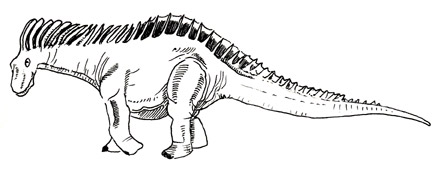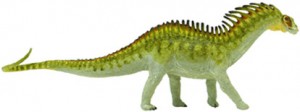Spectacular Late Diplodocid Amargasaurus
Whilst on one of our fossil roadshows we were asked about the Late Jurassic sauropod Amargasaurus, a very bizarre and strange looking diplodocid from Argentina. Known from just a few partial skeletons, the first fossils were found in a dried up river bed in 1984. This particular dinosaur was named after the river (La Amarga) and the nearby town, plus the rock formation within which the fossils were discovered. Amargasaurus was named and described by Leonardo Salgado and José Bonaparte.
Amargasaurus
Amargasaurus was considerably smaller than some of its more famous relatives, although it still may have attained lengths in excess of 12 metres. The actual size of an adult Amargasaurus is unknown as the best specimen discovered to date lacked much of its tail. It had a relatively short neck compared to other diplodocids and this feature coupled with the short, blunt teeth suggests that this particular dinosaur was a browser feeding on the leaves of trees.
Closely related to the diplodocid Dicraeosaurus from Africa, Amargasaurus had two rows of tall spines jutting up from its backbone (neural spines). These spines ran from the top of the head down the neck, tapering to a single row of smaller spines that ran down the rest of the body.
An Illustration of the Bizarre Diplodocid Amargasaurus

Picture credit: Everything Dinosaur
The precise function of this structure is unknown, although it is thought that the spines on the neck were a defensive weapon. They may have been angled backwards on the neck to prevent this animal getting its head stuck in the branches of the tress that it browsed upon. The smaller spines further down the body may have supported a sail that may have been used for visual display or thermal regulation.
Strange Neural Spines
As more and more Late Jurassic/Early Cretaceous diplodocids are discovered, Amargasaurus with its strange neural spines may be seen as very typical of this particular branch of the sauropod family, so it may not be known as “bizarre Amargasaurus the South American show off” for much longer.
A number of models of this dinosaur have been produced. For example Safari added a model of this dinosaur to the Carnegie Dinosaur Collectibles range a couple of years ago.
Interpretation of Amargasaurus (Carnegie Collectibles Series)
Picture credit: Everything Dinosaur
The model illustrated is the Carnegie Collectibles Amargasaurus dinosaur model.
The body proportions are well represented and short neck clearly shown. The animal is depicted in shades of green, perhaps in reflection of the green and brown world this dinosaur inhabited. The dashes of yellow, black and brown close to the larger spines indicate that the designers of this particular model saw the spines as a signalling device, perhaps used to communicate with other members within the herd.
To view the range of dinosaur, pterosaur and other prehistoric animal models available from Everything Dinosaur: Dinosaur and Prehistoric Animal Models.







Leave A Comment